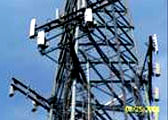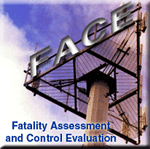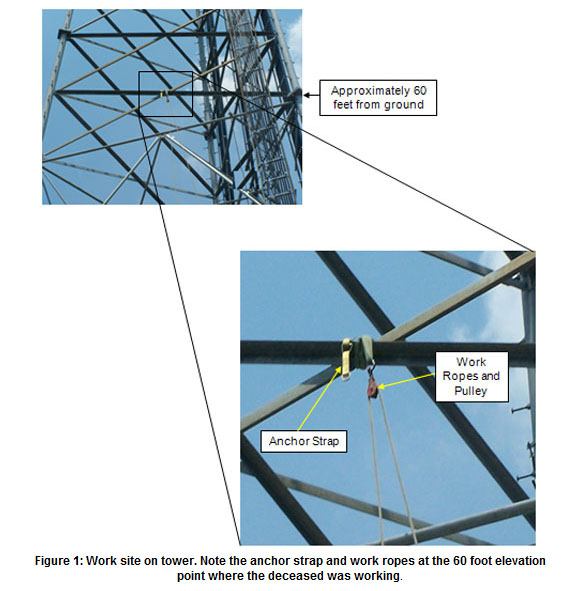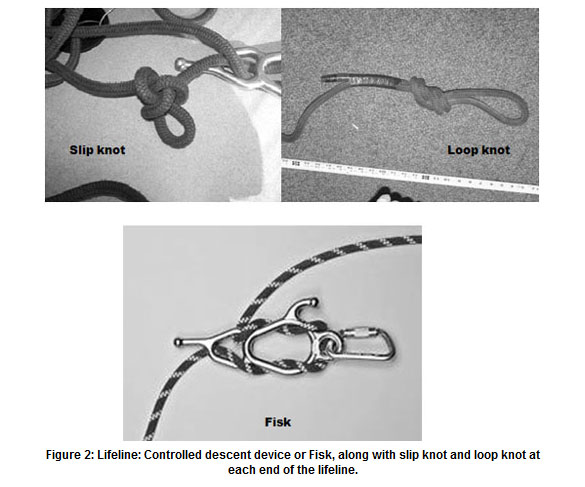NIOSH Fatality Assessment and Control Evaluation (FACE) Program
55-Year-Old Communications Tower Worker Killed
After Falling 60 Feet
|
| New Jersey Case Report: 08NJ052 |
Report Release Date: November 5, 2010
Report Date: March 10, 2010 |
Summary (top)
On July 18, 2008, a 55-year-old male communications tower worker died after falling 60 feet from a self-supported tower to the ground. On the day of the incident, the decedent and three other workers were performing structural upgrades to a 280-foot-tall communications tower in southern New Jersey. Two workers, including the victim, were stationed on the southeast face of the structure at a height of 60 feet. While the victim was preparing to ready his position to finish working, he fell backwards from the tower to the ground, and died instantly. NJ FACE investigators recommend that these safety guidelines be followed to prevent similar incidents:
 Tower workers should utilize a separate fall protection system when employing vertical lifelines or controlled descent devices. Tower workers should utilize a separate fall protection system when employing vertical lifelines or controlled descent devices.- Communication tower employees should be trained on the proper use of tower climbing and fall protection equipment.
- A safety and health plan based on a job hazard analysis should be developed by the employer and followed for each tower climb where workers are assigned tasks.
Program Objective (top)
The goal of the Fatality Assessment and Control Evaluation (FACE) workplace investigation is to prevent future work-related deaths or injuries, by a study of the working environment, the worker, the task the worker was performing, the tools the worker was using, and the role of management in controlling how these factors interact.
This report is generated and distributed solely for the purpose of providing current, relevant education to employers, their employees and the community on methods to prevent occupational fatalities and injuries.
Introduction (top)
 On July 18, 2008, a Federal OSHA compliance officer notified NJ FACE staff of the death of a 55-year-old worker who was killed after falling 60 feet from a communications tower. A NJ FACE investigator contacted the employer and arranged to conduct an investigation, which took place on August 25, 2008. During the visit, the NJ FACE investigator interviewed the immediate supervisor and colleagues of the decedent. Additional information was obtained from the medical examiner’s report, OSHA communication tower experts, and the OSHA compliance officer’s final report. On July 18, 2008, a Federal OSHA compliance officer notified NJ FACE staff of the death of a 55-year-old worker who was killed after falling 60 feet from a communications tower. A NJ FACE investigator contacted the employer and arranged to conduct an investigation, which took place on August 25, 2008. During the visit, the NJ FACE investigator interviewed the immediate supervisor and colleagues of the decedent. Additional information was obtained from the medical examiner’s report, OSHA communication tower experts, and the OSHA compliance officer’s final report.
Of the three workers on the tower the day of the incident, the victim had the most experience (>5 years) as a communications tower worker; one had been at the company for about five years and the other was relatively new. Employee health and safety training, as well as job training, was conducted on site by the employer.
Investigation (top)
 The incident occurred on a hot, humid, July day with low wind. The self-supported communications tower was situated in an off-road wooded area that had been cleared for the tower and its equipment. Three workers were assigned to change out steel diagonal structural members on the tower in preparation for new communications equipment that was to be installed. The incident occurred on a hot, humid, July day with low wind. The self-supported communications tower was situated in an off-road wooded area that had been cleared for the tower and its equipment. Three workers were assigned to change out steel diagonal structural members on the tower in preparation for new communications equipment that was to be installed.
Stronger grade steel was to be installed in place of the existing diagonals at the 20-60 foot elevation and the 120-160 foot elevation of the 280-foot tower. The crew arrived on site at approximately 8:30 am. By 9:10 am, they had begun changing out the steel diagonals at the 20- and 40-foot elevations on the northeast face of the tower (the tower is pyramidal in shape; see Figure 1), which was completed at 10:25 am.
The work ropes, which ran through pulleys to raise and lower loads and lifelines, were being relocated to the southeast tower face (seen in Figure 1). At about 10:45 am, the decedent (Worker #1) and a second crew member (Worker #2) were working at a height of approximately 60 feet on the southeast face of the tower. Each of the workers was attaching a 0.5 inch line, which was fed thorough a controlled descent device called a “Fisk,” in order to begin work on that face.
These lines, which also functioned as lifelines, were attached to the tower via an anchor strap that was fastened to a horizontal member (see Figure 1). The lifeline was fed through the metal ring on the anchor strap. The workers also each had a harness strap, which was connected to the anchor strap. None of the workers had a separate fall protection system.
The two workers attached and tested the lines. Worker #1 began to lower into a working position and suddenly fell to the ground. A coworker called 911, and police and rescue workers arrived at the scene. The responders did not find any vital signs, and the victim was pronounced dead at the scene via telemetry.
As noted above, the anchor strap was affixed to one of the horizontal beams of the tower, and was used as the connection point of the lifeline and harness strap. The victim had on a harness with various pieces of equipment attached; a lifeline was connected that also contained an in-line Fisk (the controlled descent device; see Figure 2). One end of the lifeline had a loop knot which is connected directly via carabiner to the anchor strap.
The other end of the lifeline has a slip knot which was also connected via carabiner to the anchor strap. The line was fed through the worker’s harness and through the Fisk, which he used to control his descent. When ready to descend, a worker would unhook the slip knot to allow the line to move through the Fisk, providing the ability to lower to the working elevation.
According to Worker #2, as the victim was preparing to lower himself into position, he unhooked the harness strap carabiner from the anchor strap instead of the slip knot carabiner. Then when he sat into position, the weight pulled his lifeline free from the anchor strap, and he fell backwards 60 feet to his death.
A separate fall arrest system (e.g., a separate lifeline with rope grab) could have prevented this incident. As per OSHA 29 CFR 1926.502(d), Fall protection systems criteria and practices, personal fall arrest systems, employers are required that, “…where vertical lifelines are used, each employee shall be attached to a separate lifeline.”
Recommendations/Discussion (top)
Recommendation #1: Tower workers should utilize a separate fall protection system when employing vertical lifelines or controlled descent devices.
Discussion: In this incident, the controlled descent device (Fisk) was being used as fall protection. Fisk descenders were developed by rock climbers for intermittent rappelling, or episodes of free falling followed by brief periods of control. This is not recommended for safe working conditions on a communications tower. If a proper fall arrest system is appropriately rigged, a worker cannot fall more than 6 feet before the system activates. Fisks are sometimes used because they are easier to master than other descent tools.
The preferred method of descent device, however, is the rope grab or rope brake, which enable the automatic repositioning of the connection to the separate fall protection system. These devices lock onto a line under stress, are generally attached to a static lifeline, and have either shock absorbers or the ability to stretch. In this case, a Fisk was used in place of a rope grab because the rope grab was considered by workers to be an encumbrance, and “where wind would blow, it would hit us in the head.” If a manual descending system such as a Fisk is used, a separate fall protection system must be in place.
The OSHA Fall Protection Standard, 29 CFR 1926.502(d)10i, requires that, “…where vertical lifelines are used, each employee shall be attached to a separate lifeline.” Proper fall arrest systems should also conform to ANSI/ASSE Z359.1-2007, Safety Requirements for Personal Fall Arrest Systems, Subsystems and Components, which, “Establishes requirements for the performance, design, marking, qualification, instruction, training, inspection, use, maintenance and removal from service of connectors, full-body harnesses, lanyards, energy absorbers, anchorage connectors, fall arresters, vertical lifelines and self-retracting lanyards comprising personal fall arrest systems for users within the capacity range of 130 to 310 lb (59 to 140 kg).”
Recommendation #2: Communication tower employees should be trained on the proper use of tower climbing and fall protection equipment.
Discussion: The OSHA Fall Protection Standard, 29 CFR 1926.503(a), requires that, “…a training program for each employee who might be exposed to fall hazards must be provided.”
The program trains employees to recognize the hazards of falling and the procedures to be followed in order to minimize these hazards. According to OSHA 1926, Subpart M, Appendix C, section e (full reference in Appendix), this should include, “…proper hook-up, anchoring and tie-off techniques, including the proper dee ring (carabiner or other attachment point to use on the body belt and harness for fall arrest).” Part of any training program should also include access to the NIOSH Alert, Preventing Injuries and Deaths from Falls during Construction and Maintenance of Telecommunication Towers, which is available online at: http://www.cdc.gov/niosh/docs/2001-156/).
This publication provides useful information to both employers and employers, and includes five FACE fatality narratives that all involve fatal falls during construction or maintenance of communication towers.
Recommendation #3: A safety and health plan based on a job hazard analysis should be developed by the employer and followed for each communications tower where workers are assigned tasks.
Discussion: Employers should conduct a job hazard analysis, with the participation of employees, of all work areas and job tasks. A job hazard analysis should begin by reviewing the work activities for which the employee is responsible, and the equipment that is needed.
Each task is further examined for mechanical, electrical, chemical, or any other hazard the worker may encounter. A source of information on conducting a job hazard analysis is included in the Appendix.
References (top)
Job Hazard Analysis. US Department of Labor Publication # OSHA-3071, 1998 (revised). USDOL, OSHA Publications, PO Box 37535, Washington DC 20013-7535.
NIOSH Alert: Preventing Injuries and Deaths from Falls during Construction and Maintenance of Telecommunication Towers (available at: http://www.cdc.gov/niosh/docs/2001-156/).
29 CFR Ch. XVII, Section 1926.502 (d)10i: Fall Protection systems criteria and practices.
Appendix C to Subpart M of Part 1926—Personal Fall Arrest Systems; Non-mandatory guidelines for Complying with 1926.502(d).
ANSI/ASSE Z359.1-2007: Safety Requirements for Personal Fall Arrest Systems, Subsystems and Components
Attachments (top) 
To contact New Jersey State FACE program personnel regarding State-based FACE reports, please use information listed on the Contact Sheet on the NIOSH FACE web site. Please contact In-house FACE program personnel regarding In-house FACE reports and to gain assistance when State-FACE program personnel cannot be reached.
(top)
Appendix (top)
Recommended Resources
It is extremely important that employers obtain accurate information on health, safety, and applicable OSHA standards. NJ FACE recommends the following sources of information which should help both employers and employees:
U.S. Department of Labor, Occupational Safety & Health Administration (OSHA)
Federal OSHA will provide information on safety and health standards on request. OSHA has four area offices in New Jersey that cover the following counties:
Hunterdon, Middlesex, Somerset, Union, and Warren counties
Telephone: (732) 750-3270
Essex, Hudson, Morris, and Sussex counties
Telephone: (973) 263-1003
Bergen and Passaic counties
Telephone: (201) 288-1700
Atlantic, Burlington, Cape May, Camden, Cumberland, Gloucester, Mercer, Monmouth, Ocean, and Salem counties
Telephone: (856) 757-5181
Federal OSHA
Web site: http://www.osha.gov
New Jersey Public Employees Occupational Safety and Health (PEOSH) Program
The PEOSH Act covers all NJ state, county, and municipal employees. Two state departments administer the act; the NJ Department of Labor and Workforce Development (NJDLWD), which investigates safety hazards, and the NJ Department of Health and Senior Services (NJDHSS), which investigates health hazards. PEOSH has information available that may also benefit private employers.
NJDLWD, Office of Public Employees Safety
Telephone: (609) 633-3896
Web site: http://lwd.dol.state.nj.us/lsse/employer/Public_Employees_OSH.html
NJDHSS, Public Employees Occupational Safety & Health Program
Telephone: (609) 984-1863
Web site: http://www.state.nj.us/health/eoh/peoshweb/
On-site Consultation for Public Employers
Telephone: (609) 984-1863 or (609) 633-2587
Web site: www.state.nj.us/health/eoh/peoshweb/peoshcon.htm
New Jersey Department of Labor and Workforce Development, Occupational Safety and Health On-Site Consultation Program
This program provides free advice to private businesses on improving safety and health in the workplace and complying with OSHA standards.
Telephone: (609) 984-0785
Web site: http://lwd.dol.state.nj.us/labor/index.shtml
New Jersey State Safety Council
The NJ State Safety Council provides a variety of courses on work-related safety. There is a charge for the seminars.
Telephone: (908) 272-7712.
Web site: http://www.njsafety.org
Internet Resources
Other useful internet sites for occupational safety and health information:
CDC/NIOSH - http://www.cdc.gov/niosh/
USDOL Employment Laws Assistance for Workers and Small Businesses - http://www.dol.gov/elaws/
National Safety Council - http://www.nsc.org/Pages/Home.aspx (Link updated 11/1/2010)
NJDHSS FACE reports - http://www.state.nj.us/health/eoh/survweb/face.htm
CDC/NIOSH FACE - http://www.cdc.gov/niosh/face/
OSHA - http://www.osha.gov
ANSI - http://www.ansi.org
(top)
|